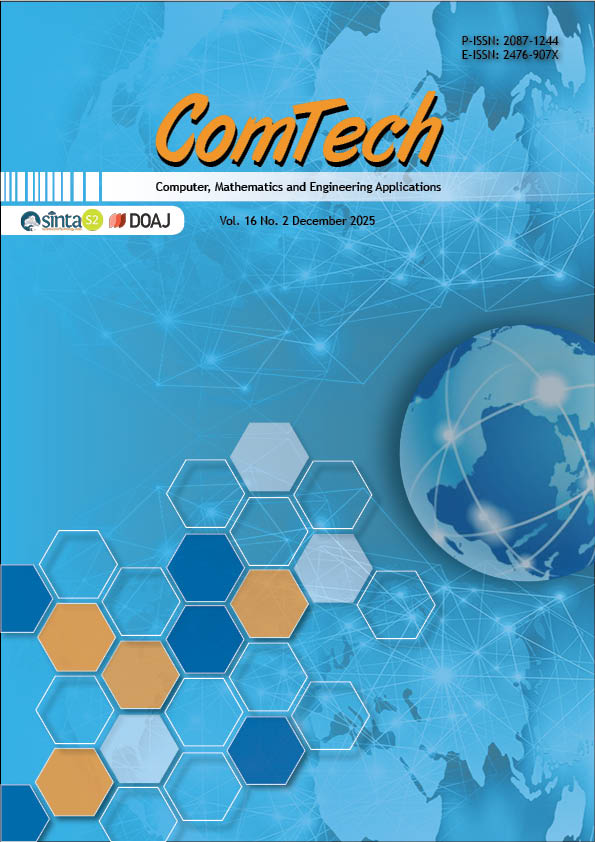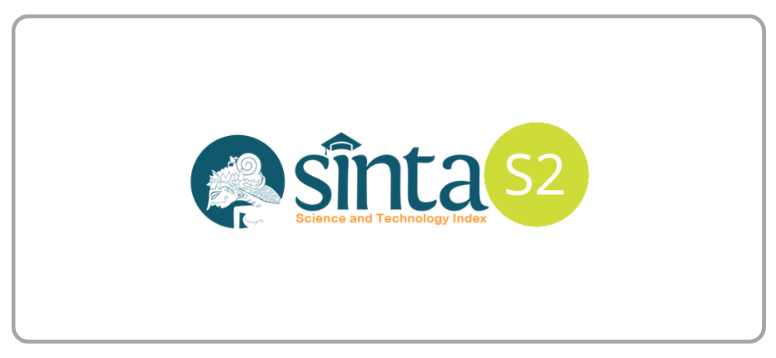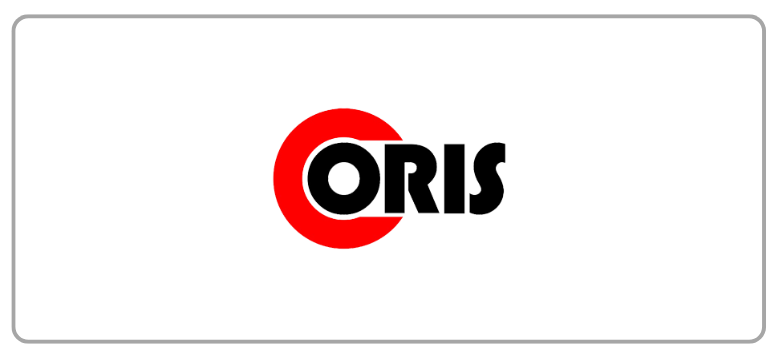Inception-ResNet-V2 The U-Net Encoder for Road Segmentation using Sentinel 2A
DOI:
https://doi.org/10.21512/comtech.v16i2.12089Keywords:
Convolutional Neural Network, U-Net, Inception ResNet V2, Encoder, Deep Learning, Computer Vision, SegmentationAbstract
Updating road network maps is essential for transportation services, as incomplete or inaccurate maps can lead to inefficiencies and diminish service quality. The online transportation industry generates vast amounts of GPS data as drivers navigate, which is valuable for mapping road networks and improving traffic management. However, since drivers do not cover all roads, satellite imagery plays a crucial role in identifying areas that are not mapped. By combining GPS data as labels with satellite imagery, the extraction of new road networks becomes more accurate. This research employs a deep learning Convolutional Neural Network (CNN) with the U-Net architecture for road segmentation, allowing for the identification of new paths. Two different encoders are tested in this research: Inception-ResNet-V2 and a pure U-Net encoder. The Inception-ResNet-V2 encoder achieves an accuracy of 91.3%, while the pure U-Net encoder achieves 90.7%. In terms of Dice Loss, the models record values of 0.051 and 0.08, respectively. The research highlights the effectiveness of different U-Net encoders in road network segmentation. With high accuracy and low Dice Loss, this approach provides a reliable method for automatically updating road maps. It has potential applications in navigation systems, urban planning, and AI-driven intelligent transportation systems.
References
Baek, W. K., Lee, M.-J., & Jung, H.-S. (2024). Land cover classification from RGB and NIR satellite images using modified U-Net Model. IEEE Access, 12, 69445–69455. https://doi.org/10.1109/ACCESS.2024.3401416
Chen, B., Ding, C., Ren, W., & Xu, G. (2021). Automatically tracking road centerlines from low-frequency GPS trajectory data. ISPRS International Journal of Geo-Information, 10(3). https://doi.org/10.3390/ijgi10030122
Joubert, N., Reid, T. G. R., & Noble, F. (2020). Developments in modern GNSS and its impact on autonomous vehicle architectures. 2020 IEEE Intelligent Vehicles Symposium (IV), 2029–2036. https://doi.org/10.1109/IV47402.2020.9304840
Kamalov, F. (2020). Kernel density estimation based sampling for imbalanced class distribution. Information Sciences, 512, 1192–1201. https://doi.org/https://doi.org/10.1016/j.ins.2019.10.017
Liu, Y., Jia, R., Ye, J., & Qu, X. (2022). How machine learning informs ride-hailing services: A survey. Communications in Transportation Research, 2, 100075. https://doi.org/https://doi.org/10.1016/j.commtr.2022.100075
Luthfil, P., Program Doktor, H., Wasanta, T., & Santosa, W. (2021). Pengaruh indeks infrastruktur jalan terhadap indikator ekonomi di Indonesia. Jurnal HPJI (Himpunan Pengembangan Jalan Indonesia), 7(2), 143-152.
Pinuji, S., Savitri, A. I., Noormasari, M., Wijaya, D. K., & Kurniawan, A. (2019). Efektivitas data spasial peta Rupa Bumi Indonesia (RBI) dan Openstreetmap dalam pengambilan keputusan menggunakan Inasafe. Jurnal Dialog Penanggulangan Bencana, 10(1), 22-29. https://api.semanticscholar.org/CorpusID:238144783
Pommé, L.-E., Bourqui, R., Giot, R., & Auber, D. (2022). Relative Confusion Matrix: Efficient comparison of decision models. 2022 26th International Conference Information Visualisation (IV), 98–103. https://doi.org/10.1109/IV56949.2022.00025
Ramba, L. S. (2020). Design of a voice controlled home automation system using Deep Learning Convolutional Neural Network (DL-CNN). Telekontran : Jurnal Ilmiah Telekomunikasi, Kendali Dan Elektronika Terapan, 8(1), 57–73. https://doi.org/10.34010/telekontran.v8i1.3078
Sun, T., Di, Z., Che, P., Liu, C., & Wang, Y. (2019). Leveraging crowdsourced GPS data for road extraction from aerial imagery. 2019 IEEE/CVF Conference on Computer Vision and Pattern Recognition (CVPR), 7501–7510. https://doi.org/10.1109/CVPR.2019.00769
Tuli, T. B., Kohl, L., Chala, S. A., Manns, M., & Ansari, F. (2021). Knowledge-based digital twin for predicting interactions in human-robot collaboration. 2021 26th IEEE International Conference on Emerging Technologies and Factory Automation (ETFA ), 1–8. https://doi.org/10.1109/ETFA45728.2021.9613342
Wang, J., Liu, Y., & Chang, J. (2022). An improved model for Kernel Density estimation based on Quadtree and Quasi-Interpolation. Mathematics, 10(14). https://doi.org/10.3390/math10142402
Wang, R., Cai, M., Xia, Z., & Zhou, Z. (2023). Remote sensing image road segmentation method integrating CNN-Transformer and UNet. IEEE Access, 11, 144446–144455. https://doi.org/10.1109/ACCESS.2023.3344797
Wei, Y., Zhang, K., & Ji, S. (2019). Road network extraction from satellite images using CNN based segmentation and tracing. IGARSS 2019 - 2019 IEEE International Geoscience and Remote Sensing Symposium, 3923–3926. https://doi.org/10.1109/IGARSS.2019.8898565
Xu, Z., Yin, Y., Dai, C., Huang, X., Kudali, R., Foflia, J., Wang, G., & Zimmermann, R. (2020). Grab-Posisi-L: A labelled GPS trajectory dataset for map matching in Southeast Asia. Proceedings of the 28th International Conference on Advances in Geographic Information Systems, 171–174. https://doi.org/10.1145/3397536.3422218
Zhang, J., Hu, Q., Li, J., & Ai, M. (2021). Learning from GPS trajectories of floating car for CNN-based urban road extraction with high-resolution satellite imagery. IEEE Transactions on Geoscience and Remote Sensing, 59(3), 1836–1847. https://doi.org/10.1109/TGRS.2020.3003425
Zhang, P., He, H., Wang, Y., Liu, Y., Lin, H., Guo, L., & Yang, W. (2022). 3D urban buildings extraction based on airborne LiDAR and Photogrammetric Point Cloud Fusion according to U-Net deep learning model segmentation. IEEE Access, 10, 20889–20897. https://doi.org/10.1109/ACCESS.2022.3152744
Zhao, R., Qian, B., Zhang, X., Li, Y., Wei, R., Liu, Y., & Pan, Y. (2020). Rethinking Dice Loss for Medical Image Segmentation. 2020 IEEE International Conference on Data Mining (ICDM), 851–860. https://doi.org/10.1109/ICDM50108.2020.00094
Downloads
Published
How to Cite
Issue
Section
License
Copyright (c) 2025 Bayu Yanuargi, ema utami

This work is licensed under a Creative Commons Attribution-ShareAlike 4.0 International License.
Authors who publish with this journal agree to the following terms:
a. Authors retain copyright and grant the journal right of first publication with the work simultaneously licensed under a Creative Commons Attribution License - Share Alike that allows others to share the work with an acknowledgment of the work's authorship and initial publication in this journal.
b. Authors are able to enter into separate, additional contractual arrangements for the non-exclusive distribution of the journal's published version of the work (e.g., post it to an institutional repository or publish it in a book), with an acknowledgment of its initial publication in this journal.
c. Authors are permitted and encouraged to post their work online (e.g., in institutional repositories or on their website) prior to and during the submission process, as it can lead to productive exchanges, as well as earlier and greater citation of published work.
 USER RIGHTS
 All articles published Open Access will be immediately and permanently free for everyone to read and download. We are continuously working with our author communities to select the best choice of license options, currently being defined for this journal as follows:




















